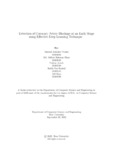Detection of coronary artery blockage at an early stage using effective deep learning technique
Abstract
A coronary artery blockage is a form of coronary artery disease also known as CAD.
It is the most common and frequent disease affecting the human body over the age
of 65. CAD is a type of cardiovascular disease that happens because of a disorder
in the coronary arteries of the human heart. Stenosis is the abnormal narrowing of
the coronary artery due to the buildup of cholesterol which results in poor blood
circulation causing a blockage. The development of computer science technologies
has made drastic changes in medical science practices that include cardiology. Such
advancements have made the invention of medical tests like Angiogram, Electrocardiogram, Magnetic Resonance Imaging, Echocardiogram, etc. These are imaging
techniques to visualize arterial and venous vessels throughout the body for the diagnosis of various diseases. In common medical practice, the analysis and diagnosis
of CAD mainly rely on the visual inspection and calculation of measurements by
experienced cardiologists and doctors. Our proposed method aims toward a fully
automated system for detecting a coronary artery blockage at an early stage using
image processing and deep learning techniques so that the system can help doctors
as well as patients to improve the medical treatment of the heart at an early stage.
The goal of this research is to implement a system that can detect stenosis areas
of the coronary artery due to the buildup of cholesterol plaque and other blocking
agents. To examine stenosis in the coronary artery, Angiogram images are essential.
Evaluating 2,151 Angiogram Image Dataset we train and test our models to reach
a conclusion. The research uses CNN architecture models that use a dataset of
2D Angiogram images of the segmented coronary arteries which are analyzed using
VGG16, VGG19, ResNet50, InceptionV3, and DenseNet121 models. To enhance
our study, we classified our dataset into two classes i.e Binary Classification and
Multiclass Classification. Next, using Ensemble model architecture, we evaluate the
results and accuracy of the models used in the procedure of identifying coronary
artery blockage. We used evaluation metrics Accuracy, Precision, Recall, and F1
Score to evaluate our results. Finally, we achieved accuracy, precision, recall, and
F1 Score of more than 0.99 for the Binary Classification and more than 0.98 for
the multiclass classification respectively of our dataset. In this way, the use of deep
learning techniques can improve and develop medical science at a prodigious level
resulting in error-free medical treatment of the heart at an early stage.

